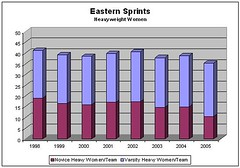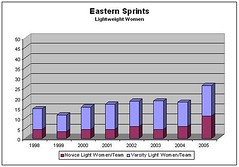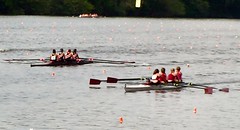This article in Princeton’s Daily Princetonian is just too much to resist. It discusses the JP (Junior Paper, I’m guessing?) of Princeton male lightweight Jordan Bice, which explores “the social dynamics of the boathouse and how current media and social pressures affect those dynamics.” The meat of the article as far as FITD is concerned is the following, which discusses the boathouse pecking order:
In the Princeton boathouse, it is as follows: heavyweight men first, lightweight men second, open women third and lightweight women fourth.
"When I asked why that was fair to the teams, they were like [sic], 'It's just the way sports is, it's a meritocracy,'" Bice said.
Bice's study suggested that the heavyweight men and open women as teams seem to show more athleticism than the lightweight men, and if the boathouse really does operate under a meritocracy, the resources weren't divided solely on the basis of athletic merit.
"My own personal experience is that the best athletes are the openweight women, the heavyweight men, the lightweight men and the lightweight women in that order," Bice said.
When Bice noted this discrepancy between what the pecking order should be based on his study and what was actually seen in the boathouse, he decided to examine why the "meritocracy" theory wasn't quite correct.
Whoa, this is a mouthful! Since lightweight women are the least athletic and lowest in the pecking order, according to Bice, they are not discussed after this passage. Before I peck apart Bice’s opinions, let’s understand the personal context in which he operates. First, he is himself a member of a group he is studying, hardly a disinterested observer. This shows through in his pecking order. Secondly, we should note his background. “Hailing from Berkley, Calif., Bice has always lived in a politically active community and has been interested in racial and other forms of institutionalized inequality from the time he was in high school.”
Remember the word "suggested" from the anorexia articles I looked at over the winter? As we saw then, it's a code word for "I want to believe this, but have no actual evidence to support it." One of Bice’s key assumptions is that there is an objective way to compare rowers among teams, not just within teams – the “meritocracy” idea. He orders the teams, however, from best to worst athletes based on “my own personal experience.” That doesn’t sound very objective. Athleticism is not defined. Not one criterion is listed that Bice used to determine the better athletes. Did he use weight adjusted erg scores? Did he use vertical leap as percentage of height? Did he use three mile run times? We have no idea. I hope Princeton requires better work of its students, but since we don’t actually have Bice’s paper, we can’t know. The result is that we’re left with Jordan Bice’s counterintuitive subjective opinion about which team contains the better athletes. The very thesis of his paper seems to be based on an unsupported opinion.
Perhaps most humorous is his pecking order. Now, I really don’t know the actual pecking order in Princeton’s boathouse, but I’m guessing that Jordan spent a lot of time talking to lightweight men (his own team). I’ll give him lightweight women at the bottom, but I won’t give him lightweight men at number two. Sorry guys, you’re three, particularly this year at Princeton. Again, Bice is a member of the group he is studying, comes up with a result that puts his group in a relatively good light, and then goes on to agonize over why this result is so when he thinks they really don’t deserve it (note background). If, on the other hand, he found his group to be third in the pecking order, end of paper, find a new topic. If we dispense with political correctness, the boathouse pecking order is pretty simple. Rowing is a strength sport. As such, the pecking order goes from strongest to weakest, masculine to feminine. First and fourth are obvious, there’s a struggle for second and third.
At the end, Bice manages to slam female lightweights without even mentioning them. Speaking of the heavy women the article says,
The team just doesn't ‘go there’ and ‘it would be totally inappropriate’ to talk about weight or tell a girl she was too heavy. Bice also commented, however, on how the team members encourage each other to eat a lot, including carbohydrates.
'Part of their identity is they're girls who eat a lot, and they were sort of proud to take that on.'
Golly, imagine telling an athlete she ought to lose some weight because you’re getting tired of dragging her butt down the river. Wouldn’t be a problem on a men’s team would it? Oh, that’s right, the fragile psyche of a woman.
The notion that Bice determined that lightweight women are the worst athletes in the boathouse is just silly. He offers no definition of an athlete, no supporting evidence, and admits himself that it came from “his experience.” In addition, I would imagine that his boathouse pecking order is self-fulfilling. Finally, he throws in a gratuitous discussion of how we should further recognize the superiority of female heavies (and by implication the inferiority of female lights) as a result of their rejection of traditional standards of beauty and their embrace of heavy eating. Call me an oppressor if you must Jordan, but I embrace traditional standards of beauty.
I was going to leave you with a few "totally inappropriate" links to Bice’s “best athletes in the boathouse” from this year's Big East Championships, but I just can't do it. Instead I'll... well, I'll just eat a funnel cake at Dad Vail.
[Update: See comments for more.]









